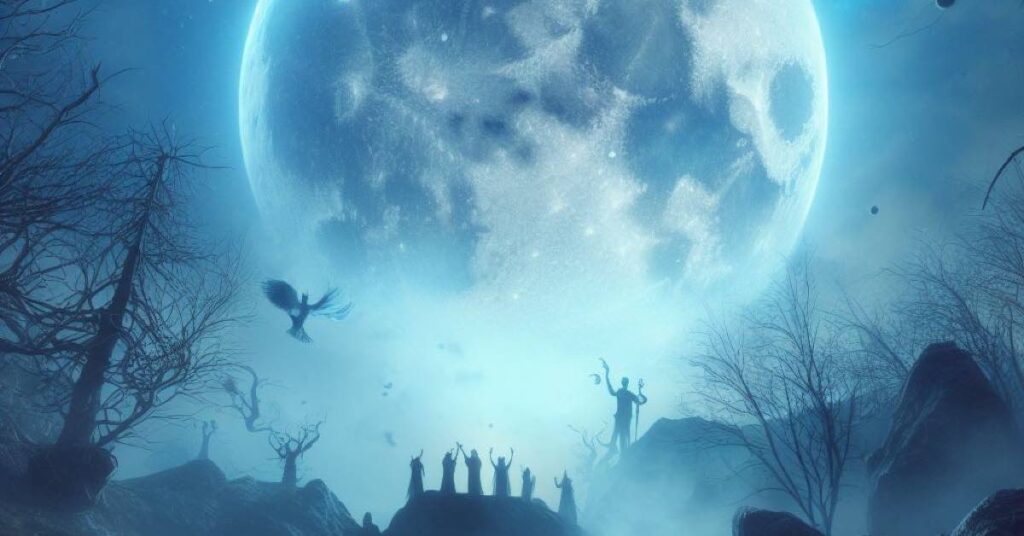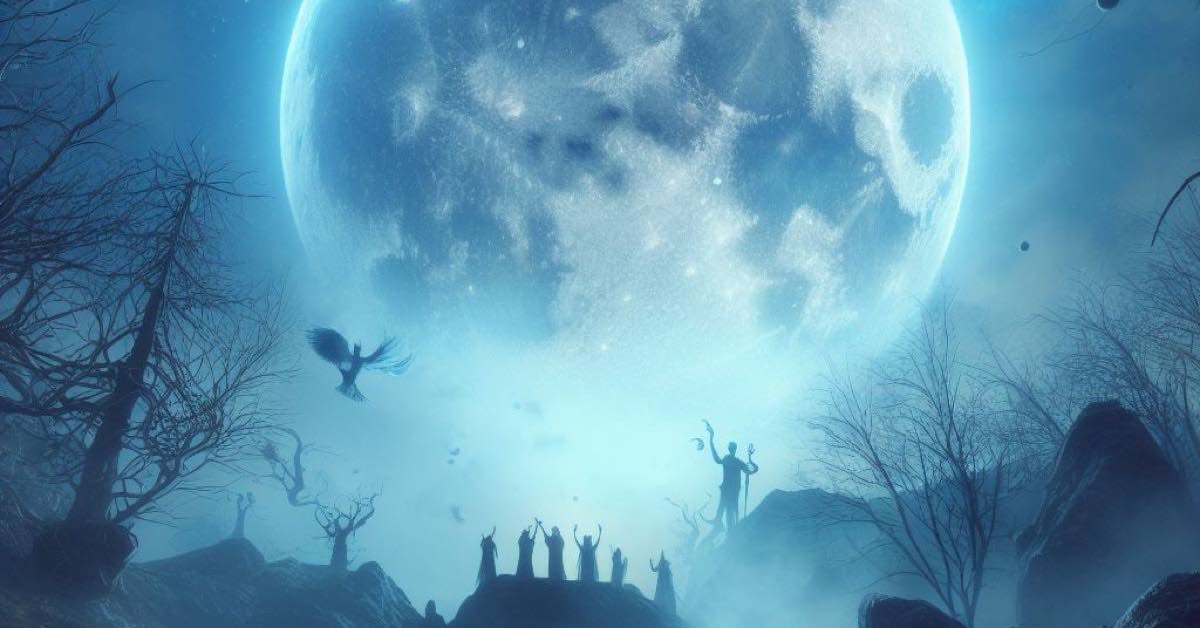As the silver orb illuminates the night sky, casting an aethereal glow that has captivated humans for centuries, we find ourselves drawn to its mysterious allure. The moon, a celestial body so seemingly close yet unattainable, has held a prominent place in the mythology and folk-lore of cultures around the world. From ancient legends of lunar deities to modern astrological beliefs, its influence on human lives cannot be underestimated. Here, we embark on a journey through time and space to explore the captivating realm of moon mythology and folk-lore from an astrological perspective.

Exploring the Mysteries of the Moon
The Moon has long been the subject of fascination and wonder for humanity, captivating our imaginations in both science and folk-lore. From ancient civilisations to modern times, cultures around the world have shared storeys and myths about this celestial body. While scientific exploration has shed light on many of the moon’s mysteries, there are still enigmas to be unravelled.
One intriguing aspect of the Moon is its connection to emotions and consciousness. In astrology, the Moon symbolises our deepest emotions, innermost desires, and instinctual reactions. Its ever-changing cycle mirrors our own ebb and flow of moods. Exploring these lunar influences can provide valuable insights into our psyches and help us navigate life’s challenges.
In addition to its impact on human emotions, the Moon also holds a significant place in folk-lore as a mystical being capable of shape-shifting or influencing behaviour. The tales vary across cultures but often depict the moon as a deity or guardian watching over us from above. This portrayal reflects our innate desire to find meaning in something larger than ourselves – an aethereal force guiding us through life’s uncertainties.
As we delve deeper into both scientific understanding and cultural beliefs surrounding the Moon, we uncover a tapestry rich in symbolism and mystery. By examining these connections from an astrological perspective, we gain greater insight into ourselves and a deeper appreciation for this celestial companion that has fascinated humans since time immemorial.
The Lunar Influence on Human Emotions
The moon has long been revered for its mystical qualities and its influence on human emotions. Throughout history, various cultures have associated the lunar cycles with changes in mood and behaviour. While scientific research is inconclusive about any direct physiological effects of the moon on humans, there are intriguing connections between lunar phases and emotional states.
One such connection can be seen in the belief that a full moon heightens emotional intensity. The idea that people become more emotional or erratic during a full moon is deeply intrenched in popular mythology. This phenomenon is often referred to as lunar lunacy or the Transylvania effect, as it was historically associated with werwolves and other supernatural creatures transforming under the light of a full moon.
Another interesting aspect of the lunar influence on human emotions lies in its ability to create a sense of reflection and introspection during certain phases. During new moons, when the moon’s dark side faces Earth, many individuals report feeling a deep need for solitude and self-reflection. During this phase, we may contemplate our past actions and assess our future goals. The absence of bright moonlight can enhance feelings of introspection, allowing us to delve deeper into our thoughts and emotions.
As we explore these fascinating connections between lunar influences and human emotions, it becomes evident that while science may not fully validate these beliefs, they have undeniable cultural significance. Whether it’s acknowledging heightened emotion during a full moon or seeking moments of solitude during new moons for introspection, understanding these
Moon Deities and Divine Connections
In many ancient cultures, the Moon was seen as a deity with divine powers and mysterious connections to the human world. From Artemis in Greek mythology to Chang’e in Chinese folk-lore, moon deities have shaped cultural beliefs and rituals. These celestial beings were often associated with femininity, fertility, and protection.
Moon deities also had a significant influence on natural phenomena and cycles. The waxing and waning of the Moon was thought to be connected to the ebb and flow of tides, while its phases were believed to govern agricultural activities such as planting and harvesting. This close association between moon deities and earthly endeavours highlights the interconnectedness between humans, nature, and celestial forces.
Interestingly enough, moon deities were not limited to just one culture or group. Across different civilisations around the world, similar lunar representations emerge. This suggests that these divine connections transcend geographical boundaries and reflect universal aspects of human experience. Whether worshipped as Artemis Ix Chel or Tsukuyomi-no-Mikoto, moon deities continue to inspire awe for their enduring presence throughout history. Their enduring legacy serves as a reminder of our deep-rooted fascination with the enigmatic lunar realm and its significance in our lives.
Cultural Myths and Legends Surrounding the Moon
The moon has always held a mystical allure, captivating cultures across the globe with its aethereal beauty and enigmatic presence. From ancient beliefs to modern folk-lore, the moon has been steeped in a rich tapestry of cultural myths and legends that continue to fascinate us even in this age of scientific understanding. In Norse mythology, for example, the moon is believed to be Máni, a god who traverses the night sky with his sister Sol (representing the sun). This myth describes how Máni was pursued by two wolves named Hati and Skoll, explaining lunar eclipses as their attempts to devour him.
Similarly, East Asian cultures have their own captivating tales about the moon. In Chinese folk-lore, people believe in Chang’e—a woman who became an immortal residing on the moon. Legend says she was forced to consume an elixir of immortality after her husband stole it from heaven. As punishment for their forbidden act, they were banished to different realms—the husband becoming a mortal on Earth. At the same time, Chang’e ascended to reside on the glowing surface of our celestial neighbour.
Astrological Significance of the Moon’s Phases
The Moon, with its ever-changing phases, has long captivated humanity’s imagination. From ancient times to the present day, its cycles have been associated with a multitude of mythologies and folk-lore from around the world. Astrologically speaking, each phase of the Moon holds significant meaning and influences various aspects of our lives.
During the New Moon phase, when the Moon is not visible in the night sky, we are presented with a clean slate for new beginnings. It symbolises fresh starts, planting seeds for future growth, and setting intentions. This is an ideal time for introspection and self-reflection – a moment to identify what we wish to manifest in our lives and set goals accordingly.
As the Moon transitions into its Waxing Crescent phase, it signifies a period of growth and development. Just like the tiny sliver of light that begins to peek through after the New Moon, this stage encourages progress and taking small steps towards our objectives. It is an opportune time to take action on our intentions by making plans or starting new projects.
Each subsequent lunar phase brings about different energies and opportunities for personal growth depending on where it falls in your natal chart. By understanding these astrological significances of each Moon phase, we can align ourselves better with cosmic forces while navigating life’s journey with intentionality and grace.
Rituals and Practises to Harness Lunar Energy
One of the most fascinating aspects of lunar energy is its ability to affect the ebb and flow of our emotions. Just as the moon controls the tides, it also profoundly impacts our internal world. By understanding and harnessing this energy, we can tap into a wellspring of emotional clarity and intuition.
A powerful ritual for connecting with lunar energy involves creating a sacred space in your home dedicated solely to moon-related activities. This could be a small altar adorned with crystals, candles, and images or symbols associated with the moon such as silver or incense. Each night, take a few moments to sit in front of your altar and meditate on the lunar energy you wish to invite into your life. Allow yourself to feel connected to the cycles of nature and visualise your intentions being set in motion.
In addition, practising gratitude under the moonlight can help amplify positive energies within us and attract more abundance into our lives. During the full moon phase, take some time each month to write down what you are grateful for in a journal specifically designated for this purpose. As you reflect on what you have written, allow feelings of appreciation and joy to fill your heart. By actively cultivating gratitude under the influence of lunar energy, we can create an abundant mindset that attracts more blessings into our lives.
Harnessing lunar energy is about performing rituals and cultivating awareness and mindfulness in our daily lives.
The Enduring Power of Lunar Mythology
In conclusion, the enduring power of lunar mythology lies in its ability to tap into something deep and primal within us. It is not simply a collection of ancient storeys and superstitions but a reflection of our fears, desires, and hopes. The moon has always held a special place in human consciousness, guiding our calendars and inspiring our imaginations. Its cycles mirror the rhythms of our own lives, reminding us of the inevitability of change and transformation.
Furthermore, lunar mythology serves as a powerful metaphor for the dualities that exist within us all. Just as the moon waxes and wanes, we too experience growth and decline throughout our lives. This symbolism can give us comfort in times of uncertainty or upheaval, reminding us that even when we are at our darkest moments, there is always potential for renewal and rebirth.
Ultimately, moon mythology reminds us of the interconnectedness between humanity and the natural world. It invites us to look beyond ourselves, gazing up at the night sky with wonder and curiosity. By exploring these ancient tales passed down through generations, we can gain a deeper appreciation for the mysteries surrounding us and find solace in knowing that we are part of something much greater than ourselves. The enduring power of lunar mythology lies not only in its ability to captivate our imaginations but also in its ability to help make sense of our own existence on this vast cosmic journey.
